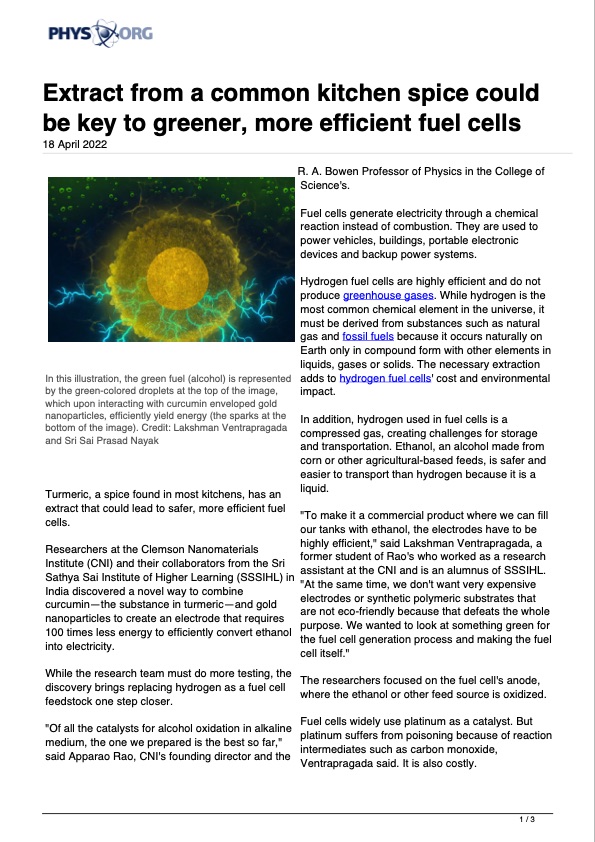
PDF Publication Title:
Text from PDF Page: 001
Extract from a common kitchen spice could be key to greener, more efficient fuel cells 18 April 2022 In this illustration, the green fuel (alcohol) is represented by the green-colored droplets at the top of the image, which upon interacting with curcumin enveloped gold nanoparticles, efficiently yield energy (the sparks at the bottom of the image). Credit: Lakshman Ventrapragada and Sri Sai Prasad Nayak Turmeric, a spice found in most kitchens, has an extract that could lead to safer, more efficient fuel cells. Researchers at the Clemson Nanomaterials Institute (CNI) and their collaborators from the Sri Sathya Sai Institute of Higher Learning (SSSIHL) in India discovered a novel way to combine curcumin—the substance in turmeric—and gold nanoparticles to create an electrode that requires 100 times less energy to efficiently convert ethanol into electricity. While the research team must do more testing, the discovery brings replacing hydrogen as a fuel cell feedstock one step closer. "Of all the catalysts for alcohol oxidation in alkaline medium, the one we prepared is the best so far," said Apparao Rao, CNI's founding director and the R. A. Bowen Professor of Physics in the College of Science's. Fuel cells generate electricity through a chemical reaction instead of combustion. They are used to power vehicles, buildings, portable electronic devices and backup power systems. Hydrogen fuel cells are highly efficient and do not produce greenhouse gases. While hydrogen is the most common chemical element in the universe, it must be derived from substances such as natural gas and fossil fuels because it occurs naturally on Earth only in compound form with other elements in liquids, gases or solids. The necessary extraction adds to hydrogen fuel cells' cost and environmental impact. In addition, hydrogen used in fuel cells is a compressed gas, creating challenges for storage and transportation. Ethanol, an alcohol made from corn or other agricultural-based feeds, is safer and easier to transport than hydrogen because it is a liquid. "To make it a commercial product where we can fill our tanks with ethanol, the electrodes have to be highly efficient," said Lakshman Ventrapragada, a former student of Rao's who worked as a research assistant at the CNI and is an alumnus of SSSIHL. "At the same time, we don't want very expensive electrodes or synthetic polymeric substrates that are not eco-friendly because that defeats the whole purpose. We wanted to look at something green for the fuel cell generation process and making the fuel cell itself." The researchers focused on the fuel cell's anode, where the ethanol or other feed source is oxidized. Fuel cells widely use platinum as a catalyst. But platinum suffers from poisoning because of reaction intermediates such as carbon monoxide, Ventrapragada said. It is also costly. 1/ 3PDF Image | Curcumin more efficient fuel cells

PDF Search Title:
Curcumin more efficient fuel cellsOriginal File Name Searched:
2022-04-common-kitchen-spice-key-greener.pdfDIY PDF Search: Google It | Yahoo | Bing
Salgenx Redox Flow Battery Technology: Salt water flow battery technology with low cost and great energy density that can be used for power storage and thermal storage. Let us de-risk your production using our license. Our aqueous flow battery is less cost than Tesla Megapack and available faster. Redox flow battery. No membrane needed like with Vanadium, or Bromine. Salgenx flow battery
| CONTACT TEL: 608-238-6001 Email: greg@salgenx.com | RSS | AMP |